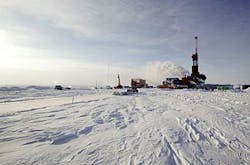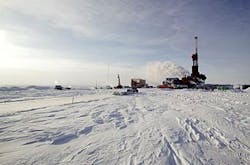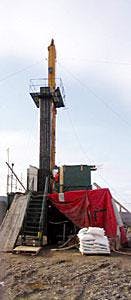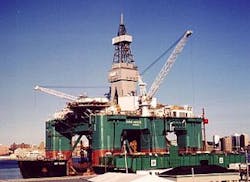Land rig counts are up, independents are investing more in North America, and a new US Securities and Exchange Commission statement eases regulations for deep water drilling in the Gulf of Mexico.
US land rig drilling is up 19% and Canadian drilling is up 41% from a year ago, according to Baker Hughes Inc.'s North American rotary rig counts for Apr. 30, 2004.
US offshore drilling has fallen 12% and Gulf of Mexico drilling is down 9% from a year ago, but the overall North American rig count is still up 18% from end-April 2003.
Texas, Oklahoma, and Louisiana led the nation in rotary rig operations for the week of Apr. 30, accounting for 72% of all working US rigs. There were 502 rigs operating in Texas, 165 in Oklahoma, and 174 in Louisiana.
In his weekly drilling review for Apr. 19, Prudential Securities analyst Grant Borbridge said that Gulf of Mexico jack up utilization improved to 83% from 78% in 2 weeks. He noted that the barebones jack up rig supply is the lowest in 10 years.
According to Lehman Bros. analysts, based on data from the American Petroleum Institute, total US well completions increased 1.9% to 9,072 in first-quarter 2004. Gas well completions increased 235 (4%) to 6,059, and oil well completions increased 89 (4.4%) to 2,114.
Total US footage drilled increased 1.5% to 49.1 million ft in first-quarter 2004, although the average depth per well was down 22 ft, to 5,413 ft.
The Weatherford Intl. Inc. and Assoc. of Energy Service Co.'s US well service rig count increased by four rigs in March to 2,047.
The count is up 5% from last year and service rig fleet utilization is at 63%.
The Baker Hughes North American work over rig count was 1,687 for March 2004, down 13% (252 rigs) from February 2004, but up 10% (147 rigs) from a year ago.
null
US independents
Securing contract drilling services has become more difficult in the past year, according to the Grant Thornton survey released Apr. 5, 2004. Of the 60 respondents in 2004, 22% said they had difficulty getting services, compared with only 8% of respondents in the 2003 survey group.
The percentage of respondents who believe that it will become more difficult to obtain contract-drilling services in the next year has increased to 52% in 2004 from 46% in 2003.
In order to expect a 20% increase in US drilling activity, 71% of respondents needed to see the price of natural gas equal or exceed $5.00/Mcf. Likewise, 74% of respondents needed to see the price of West Texas Intermediate crude meet or exceed $30/bbl in order to expect a 20% increase in drilling activity.
Most US independent oil and gas companies plan to increase both exploration and development spending in the US in 2004.
Thirty percent of respondents plan to increase domestic exploration spending significantly (more than 20%), and 40% of respondents plan to increase domestic exploration spending somewhat (up to 20%).
For domestic development, 32% plan to increase spending significantly (more than 20%), and 48% of respondents plan to increase domestic development spending somewhat (up to 20%).
Independents are less interested in expanding their current overseas spending. Only 21% of respondents intend to increase international exploration spending, and only 16% plan to increase international development spending in 2004.
Only 27% of the 60 companies responding to the 2004 survey are publicly traded. Most are private companies registered as S corporations (38%) or C corporations (35%).
Grant Thornton LLP is the US member of Grant Thornton Intl.
null
Gulf regulation softened
A recent letter from the US SEC said that production flow tests are no longer required on deepwater discovery wells before reporting proven reserves in the Gulf of Mexico. The lifting of this requirement will probably reduce well costs and perhaps lead to additional deepwater drilling.
SEC Regulation S-X, Rule 210.4-10 (2)(i), states, "Reservoirs are considered proved if economic producibility is supported by either actual production or conclusive formation test."1
The SEC definition makes no overt allowance for using log, core, or other data to prove reserves, thereby technically requiring operators to run time-consuming and therefore expensive production tests.
In his Apr. 15 "Letter to companies with oil and gas operations in the Gulf of Mexico," H. Roger Schwall, assistant director for the office of natural resources in the SEC's corporation finance division, said that the staff will not object to companies proving reserves with open hole logs, core samples, wireline sampling, and seismic surveys in lieu of a production test in deep water.
Publicly traded US companies working in deep water are required to abide by SEC regulations, rather than the more flexible SPE/WPC definitions, which state "In certain cases, proved reserves may be assigned on the basis of logs and/or core analysis that indicate the subject reservoir is hydrocarbon bearing and is analogous to reservoirs in the same area that are producing or have demonstrated the ability to produce on formation tests."
John Hynie, deputy director of the SEC's office of public affairs, told OGJ that this letter represents a staff position that was taken on a narrow set of questions, limited to the deepwater Gulf of Mexico. The staff position is not to object to companies claiming proved undeveloped reserves if they use the alternate methods mentioned by Schwall in the letter.
Hynie said there are no plans to amend the text of Regulation S-X.
null
Fleets
After lackluster first-quarter results, Thompson-First Call analysts' estimates suggest that US-based contract drillers will benefit from improved rig activity in second-quarter 2004. Many analysts expect rigs to mobilize out of the Gulf of Mexico, which should improve prices for the remaining fleets as deep drilling gets under way.
On Apr. 20, ENSCO International Inc's Chairman and CEO Carl Thorne said, "In May, we will relocate two 250-ft jack ups from the Gulf of Mexico to the Middle East, where they will undergo enhancement until late third and early fourth quarter of 2004. ENSCO 67 will mobilize from the Gulf of Mexico to a shipyard in Singapore for major upgrade, including conversion from slot to cantilever configuration, with expected completion in late first-quarter 2005. These actions will allow us to take advantage of strong international term-work opportunities, as well as to address enhancement cost efficiencies and fleet geographic balance."
The average rate for ENSCO's operating jack up fleet worldwide was $50,200/day in first-quarter 2004, according to the company's quarterly financial statement. Rates had been relatively stable worldwide, although the day rate for ENSCO's 22 gulf jack ups rose 2.2% from the previous quarter.
Analysts at the Raymond James Energy Group believe that day rates in the worldwide jack up market are about to increase. They note that worldwide jack up utilization is currently 79.8% and have seen that demand and day rates begin to shift higher when the utilization rate is between 80-85%.
"We believe the worldwide jack up market is nearing an inflection point in utilization that will cause day rates to shift meaningfully higher than current levels. In the past, given its size, the [gulf] jack up market has fueled worldwide day rates and once the [gulf] hits an inflection point in utilization, we expect worldwide jack up rates to follow suit," said Raymond James analyst J. Marshall Adkins in the company's Apr. 19 release.
Houston-based GlobalSantaFe Corp. is getting out of land drilling but keeping the offshore fleet of 59 rigs. GSF sold 31 rigs in North and South America and the Middle East as well as a fleet of rig transport equipment to Calgary-based Precision Drilling Corp. for $316 million in early April.
Rowan Cos. Inc. added a new Tarzan-class jack up to its fleet. The Scooter Yeargain, named after Charles Wesley "Scooter" Yeargain, a retired director of Rowan, was christened Apr. 3, 2004, at Sabine Pass, Tex. The rig is designed to have the power of a Gorilla-class rig but in a smaller package, suitable for the shallow water, deep gas drilling trend in the Gulf of Mexico. Rowan's President and CEO Danny McNease said the addition of the new rig "will enhance our capability in the emerging deep shelf market."
According to Lehman Bros. Original Oil Patch Weekly from Apr. 16, Rowan Cos. has 17 projects scheduled for its Gorilla and Tarzan class rigs in the Gulf of Mexico, but three rigs are not contracted. Rowan reported a 30% rise in revenue to $170.5 million and an $11.3 million loss in first-quarter 2004.
GlobalSantaFe Corp.'s worldwide SCORE, or Summary of Current Offshore Rig Economics, for March 2004, was down 0.7% from the previous month. The SCORE compares the profitability of mobile offshore rig day rates with the profitability of rates at the peak offshore drilling cycle in 1980-81 (SCORE = 100).
The gulf was the only region with an increased SCORE for March, up 1.1%, to 38.4, from 38.0 in February. The SCORE for jack ups increased 4.5% to 54.1 from 51.8 in February, but it decreased 3.5% for semisubmersibles, to 34.6 from 35.9 in February.
Alaskan activity
A Wood Mackenzie study published last month said that the high costs of drilling in Alaska and the state's regressive tax structure put it far down the list of desirable arenas in which to drill.
Nevertheless, with high demand for gas, bidding is expected at two lease sales in Anchorage this month. The annual North Slope Foothills area-wide sale is scheduled for May 19, 2004; 1,347 tracts will be offered. The foothills area lies between Arctic National Wildlife Refuge (ANWR) and National Petroleum Reserve-Alaska (NPR-A).
Both the State of Alaska and the MMS will be offering acreage in Cook Inlet on May 19. This area-wide sale offers 815 tracts onshore and in state waters, and the MMS is offering about 2 million acres in federal waters, 3-30 nautical miles offshore, in water depths of 30-650 ft (Sale 191).
Kyle Hammond, XTO Energy Inc.'s vice-president of operations, said the company plans to drill one or two wells from its offshore platforms at Middle Ground shoal, offshore Cook Inlet in south-central Alaska. The wells will spud third or fourth-quarter 2004, and XTO is likely to be the only company drilling in the inlet this year.
XTO has already drilled eight wells at Cook Inlet, at cost from $2-3 million to $7 million/well. The company uses directional drilling techniques to intersect the vertical beds on the west flank of a structure.
ConocoPhillips Alaska Inc. is Alaska's number one oil producer and currently the state's busiest driller. In April 2003, the company proposed drilling up to six exploration wells on the NPR-A, inside the coastal zone boundary and west of the Colville River.
According to Anchorage-based Dawn Patience, ConocoPhillips has completed five exploration wells on Alaska's North Slope this winter. Three wells are in the NPR-A: Spark 2, Scout 1, and Carbon 1. Two additional wells were drilled at the Placer prospect on the western edge of the Kuparuk River Unit.
The Carbon well was spudded Mar. 4 using Doyon Drilling Inc.'s fully enclosed Doyon 19 rig with top drive (Fig. 1). Scout 1 was spudded Mar. 8, and Spark 4 on Mar. 26. The two Placer wells were spudded Feb. 27 and Mar. 21.
Drilling operations in the NPR-A are limited to a brief window when the tundra is frozen and BLM opens the area for tundra travel along ice roads.
Denver-based Forest Oil Corp. plans to drill in the underexplored Copper River basin in southern Alaska this year. Forest will be the operator; partners are Midland, Tex.-based Rutter and Wilbanks Corp. and Tulsa-based Delphi International Inc. Drilling a well to 7,000 ft is estimated to cost $3-4 million.
Anschutz Exploration Corp., Denver, won the Copper River basin exploration license in 2000, bidding $1.42 million work commitment to take place over 4 years.
Only 11 wells have been drilled in the Copper River basin to date, some with good gas shows. Four of the earlier wells were in the Anschutz license area.
Canada onshore
Prudential's Borbridge noted that Canadian land drilling has begun its seasonal downward trend as the cold weather dissipates. According to Nickle's Rig Locator, Canadian rig utilization was only 25% for the week of Apr. 29, 2004; 176 rigs were active out of a fleet of 703.
During the week ending Apr. 23, there were 391 completions in Canada, for a total of 6,929 through mid-April.
The top Canadian operators for the week were independent EnCana Corp. (43); Anadarko Canada Corp. (10); Talisman Energy Inc. (9); Canadian Natural Resources Ltd. (8); and Petro-Canada Corp. (8).
EnCana dominated drilling activity in Canada during first-quarter 2004, drilling 1,587 wells (25% of the 6,278 total drilled). Canadian Natural Resources Ltd. and Burlington Resources were the second and third most-prolific drillers after EnCana.
EnCana invested $1.4 billion (Can.) in British Columbia in 2003 and drilled 270 net wells; similar to what it will probably drill in BC in 2004.
In April 2004, EnCana CEO Gwyn Morgan told the Vancouver Board of Trade that the company's Greater Sierra and Cutbank Ridge finds in northeastern British Columbia "have huge potential—more potential, in fact, than any other new regional gas play" in Canada.
Calgary-based Contact Exploration Inc. drilled and continuously cored the Parson's Pond No. 1 well in West Newfoundland with a slim-hole rig but hit a fault zone at about 1,060 m, just short of the intended 1,200 m TD. Contact cemented the drill string in place without having reached the Ordovician Daniel's Harbour target zone and released the rig back to Logan Drilling Ltd. last month (Fig. 2).
The Parson's Pond area is known for surface oil seeps; this is the first well drilled targeting a structure identified with subsurface seismic data.
Contact (50% interest) and its partners (Vulcan Minerals Inc., Deer Lake Oil & Gas Inc., Crown Point Ventures Ltd., Gulf Shores Resources Ltd., and Overlord Financial Inc.) will evaluate the technical data before reentering the well next drilling season for potential up hole completions or deeper drilling.
St. John's-based Vulcan will drill two additional wells in West Newfoundland following the Parson's Pond well. In late March, the company fractured and flow-tested a 100-m section of the Fischells Brook reservoir in the Flat Bay No. 1 well, and will drill the second and third wells on the Flat Bay anticline.
BlackRock Ventures Inc., Calgary, drilled 14 wells on the Seal prospect in Northern Alberta during their winter drilling program, the company announced mid-April. The drilling program confirmed company estimates of 1.6-billion bbl heavy oil in place at Seal.
The central and eastern blocks contain 300 million bbl and have been approved for commercial development by the Alberta Energy Utilities Board (AEUB).
Canada offshore
The Canadian government appointed a panel to conduct public hearings in British Columbian coastal communities, giving any interested parties the opportunity to present opinions or information pertinent to the current moratorium on offshore oil and gas development.
The panel, "Public Review of the Federal Moratorium on Oil and Gas Activities Offshore British Columbia," conducted the hearings through May 15 as the second part of three-part review of the issue by Natural Resources Canada.
According to a government news release, British Columbia Energy and Mines Minister Richard Neufeld presented his province's position to the federal panel on Apr. 15, covering four themes related to offshore exploration: Working collaboratively with the federal government; ensuring the participation of First Nations at all stages; receipt of community and economic benefits; and the development of a reliable energy supply for British Columbia.
There were four rigs drilling off Eastern Canada in April 2004.
At the end of April, EnCana's Wemouth A-45 exploration well off Nova Scotia in Exploration License 2380 was within 200 m of TD (Fig. 3). The Eirik Raude semisubmersible, owned by Norway's Ocean Rig ASA, began the well in 5,600 ft water depth on Oct. 19, 2003, at $204,000/day. Planned TD was 6,627 m (21,736 ft) but drilling has stalled several times and has progressed only 1,566 m since the beginning of the year (average progress about 92 m/week; rig cost $15,500/m).
Ocean Rig took a 15% working interest in the well in exchange for 22.5% of well costs, maintaining a right to cap its cost at $13.5 million. EnCana is operator with 55%, partnered with Shell Canada Ltd. (30%). The rig will next drill for Repsol YPF off Cuba for $195,000/day.
EnCana intends to drill two or three additional wells off Eastern Canada later in 2004, including a Deep Panuke sour gas well in third-quarter.
Rowan Companies' super Gorilla V jack up completed the contract for the Mariner I-85 high temperature high pressure (HTHP) well in Exploration License 2409, 180 miles southeast of Halifax. Drilling had been temporarily suspended in early March and the rig evacuated because of pack ice. Mariner partners Canadian Superior Energy Inc. and El Paso Oil & Gas Canada Inc. reportedly encountered multiple gas pay zones but permanently abandoned the well in late March.
The Gorilla V was towed to Halifax and arrived in the harbor on Mar. 24. It began a contract on Apr. 23 with ExxonMobil to drill the Creed project that will require about 100 days' work.
After that, Rowan has proposed sending the Gorilla V to the North.Sea, in which case the company would move the Gorilla III to Eastern Canada for Encana's Deep Panuke project.
Marathon Oil Canada plans to drill the Crimson K-81 deepwater well on the Annapolis block, about 350 km southeast of Halifax. Marathon (40%) and partners EnCana (35%) and Murphy Oil Corp. (25%) will drill the well with Transocean's Deepwater Pathfinder, a fifth-generation dynamically positioned drillship.
The Deepwater Pathfinder will finish a Gulf of Mexico contract with ChevronTexaco Corp. this month ($135,000/day) before mobilizing to Eastern Canada for the 110-day Marathon contract ($157,300/ day).
Marathon had to await the decision of a three-member panel of the Canadian Transport Agency for permission to use a foreign-crewed vessel for the project (Decision No. 107-W-2004, issued Mar. 10, 2004).2 Ocean Rig had argued that the company's Eirik Raude semisubmersible should be used since it was crewed by Canadians, but on Feb. 13, the panel deemed the complaint without merit because the rig was not yet approved for Canadian registry.
The Canada-Newfoundland Offshore Petroleum Board (CNOPB) announced the 2004 call for bids in the Newfoundland and Labrador offshore area on Apr. 2. Five parcels in the Jeanne d'Arc Basin are being offered, covering 270,256 hectares (675,640 acres). Minimum bid for each parcel is $1 million for a 9-year license term, during which the winning bidder must drill at least one well. Sealed bids are due Nov. 17, 2004.
The results of CNOPB's 2003 lease sale were announced on Dec. 18, 2003. A consortium of Chevron Canada Resources Ltd. (50%), ExxonMobil Canada Ltd. (25%), and Imperial Oil Resources Ltd. (25%) bid on and won eight Orphan Basin leases with record setting bids, committing $672,680,000 to future exploration (OGJ, Jan. 5, 2004, p. 8). F
References
1. http://www.sec.gov/divisions/ corpfin/guidance/oilgasltr04152004.htm.
2. http://www.cta-otc.gc.ca/rulings-decisions/decisions/2004/W/ 107-W-2004_e.html.




